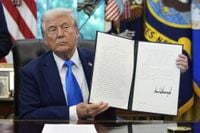On September 19, 2025, President Donald Trump signed a sweeping proclamation that could fundamentally reshape the landscape of America’s skilled worker immigration system. The order, which requires a staggering $100,000 fee for each H-1B visa application, marks the most significant overhaul of the program in decades—and it’s already sending shockwaves through the tech industry and beyond.
The H-1B visa, established in 1990, has long served as a gateway for employers to hire foreign workers with specialized skills and at least a bachelor’s degree. These visas, valid for three years and extendable once for a total of six, have become a linchpin for American technology companies and other sectors hungry for talent. According to the U.S. Department of Homeland Security, 85,000 new H-1B visas are allocated each year via a lottery, and in fiscal year 2024, nearly 400,000 applications were approved—most for renewals.
But with Friday’s proclamation, the rules of the game have changed. As reported by Bloomberg and NewsNation, the order restricts entry under the H-1B program unless accompanied by the newly imposed, six-figure fee. The White House asserts that this move is necessary to curb what it calls abuse of the pathway—a practice it claims has displaced American workers and suppressed wages.
"No more will these tech companies train foreign workers. If you’re going to train someone, you’re going to train one of our recent graduates," Commerce Secretary Howard Lutnick declared during the signing, according to NewsNation. The message is clear: the administration wants U.S. companies to look inward, prioritizing homegrown talent over international hires.
In addition to the hefty fee, President Trump has ordered the Department of Labor to revise prevailing wage levels for H-1B positions, aiming to prevent employers from undercutting American worker salaries. The White House went so far as to label the current system a national security threat, arguing in a fact sheet that "American workers are being replaced with lower-paid foreign labor," as reported by Bloomberg. The administration also contends that this "dynamic is suppressing wages and disincentivizing Americans from choosing careers in STEM fields."
For the technology sector, which has relied heavily on H-1B visas to fill specialized positions, the impact could be seismic. Amazon, for instance, has been the top employer of H-1B workers every year since 2020, with other giants like Cognizant Technology Solutions, Infosys, Tata Consultancy Services, and Google also depending on the program to staff their U.S. operations, according to Pew.
Yet, the details of the new policy remain murky. It’s unclear whether the $100,000 fee is in addition to existing costs, which currently include a $215 lottery registration fee and a $780 petition fee. The ambiguity leaves employers and applicants scrambling for clarity—and calculating the potential ramifications for their hiring plans.
Supporters and critics of the H-1B program are, unsurprisingly, deeply divided over the changes. Critics across the political spectrum have long argued that the program undercuts U.S. workers, with some contending that companies use it as a loophole to import cheaper labor at the expense of Americans. Former presidential candidate Nikki Haley, for example, posted on X, "If the tech industry needs workers, invest in our education system. Invest in our American workforce. We must invest in Americans first before looking elsewhere." Her comments echo a broader sentiment that the U.S. should focus on cultivating domestic talent rather than relying on foreign expertise.
On the other hand, supporters insist the H-1B program is vital for filling critical workforce shortages in high-skilled positions. Last year, Elon Musk waded into the debate, defending the program’s role in building America’s competitive edge. "The reason I’m in America along with so many critical people who built SpaceX, Tesla, and hundreds of other companies that made America strong is because of H1B," Musk wrote on X. He’s not alone in this view: many in the tech industry argue that the U.S. simply doesn’t produce enough qualified graduates to meet the demand for specialized roles, particularly in STEM fields.
However, even some supporters acknowledge the need for reform. Musk, for instance, has proposed raising the minimum salary requirement for H-1B positions as a way to discourage companies from using the program to hire low-cost labor. This, he suggests, would ensure that the visas go to truly high-skilled workers rather than being used to drive down wages.
The data paints a complex picture. In fiscal year 2023, 72% of approved H-1B petitions were for people born in India, while 12% went to those born in China. Men made up 71% of recipients. The vast majority of applications approved in 2024 were for renewals, not new hires, according to Pew. Rejection rates for new applications spiked during Trump’s first term but fell under President Joe Biden.
The debate over the H-1B program is as old as the visa itself. Created in 1990, the program was designed to allow U.S. employers to temporarily employ foreign workers in specialty occupations. While H-1B holders can apply for a green card during their stay, the visa itself does not provide an automatic pathway to permanent residency. For many, it’s a stepping stone—one that’s now become much more expensive to cross.
What’s next? The immediate effect of the $100,000 fee is likely to be a sharp reduction in applications, especially from smaller companies and startups that can’t afford the new price tag. Larger corporations, with deep pockets and a high demand for technical talent, may find ways to adapt, but the overall landscape is poised for a dramatic shift.
For now, the technology industry and potential visa applicants are left to watch and wait as the details of the new policy are hammered out. Will this move really protect American workers, or will it drive talent—and innovation—elsewhere? The answer, as always, may depend on whom you ask. But one thing is clear: the future of skilled immigration in America just got a lot more uncertain.
